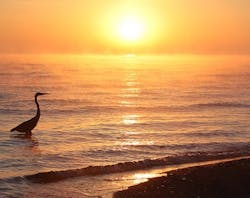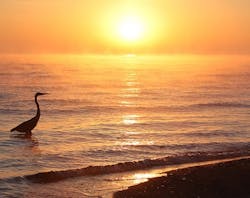U-M awarded federal contract to help lead national estuary research program
ANN ARBOR, MI, Aug. 18, 2014 -- The University of Michigan (U-M) Water Center has been awarded a five-year, $20-million cooperative-agreement contract to join the National Oceanic and Atmospheric Administration (NOAA) in overseeing research at a nationwide network of 28 coastal reserves. Less than two years after it was launched, the U-M Water Center is extending its reach beyond the Upper Midwest to help coordinate, with NOAA, the National Estuarine Research Reserve System's (NERRS) collaborative science program.
The NERRS Science Collaborative supports water-quality monitoring and long-term research on the impacts of land-use change, pollution and habitat degradation in the context of climate change trends. The overarching goal is improved stewardship of these economically significant estuaries. The 28-site reserve network includes well-known estuaries such as the Chesapeake, Delaware, Narragansett, and San Francisco bays, as well as the Hudson River, Apalachicola, Fla., and Old Woman Creek in Ohio.
The first call for research proposals could be as early as January 2015. Projects typically address a coastal management issue for a specific location, and results are used to benefit the research reserves and nearby coastal communities. More than 1.3 million acres are protected in the National Estuarine Research Reserve System, where on-site staff members, visiting scientists and graduate students study coastal ecosystems.
Under the cooperative agreement, U-M and NOAA will jointly manage the NERRS Science Collaborative, which awards an average of $4 million annually to support research. The process used for the competitively-awarded, peer-reviewed grants brings together organizations, community leaders and scientists to determine the most pressing needs of coastal communities.
A core group of nine U-M faculty researchers, staff members and students, along with partners from institutions on the east and west coasts, will guide the NERRS Science Collaborative. Through national competitions, the program will support three kinds of projects: collaborative research projects of up to $250,000 per year for up to three years; integrated assessments of up to $250,000 per year for up to two years; and science transfer projects of up to $45,000 per year for up to two years.
The U-M Water Center was launched in October 2012 with $9 million in funding and an initial goal of guiding efforts to protect and restore the Great Lakes. Financial support included a $4.5-million, three-year grant from the Fred A. and Barbara M. Erb Family Foundation and a matching commitment from the University of Michigan. U-M's Graham Sustainability Institute administers the Water Center.
Estuaries are coastal areas where rivers empty into the sea and freshwater mingles with tidal saltwater to become brackish. In addition, "freshwater estuaries" occur where rivers flow into large lakes, such as the Great Lakes, and possess many of the same characteristics as traditional brackish estuaries. An example of a freshwater estuary in the reserve system is Old Woman Creek on Lake Erie near Huron, Ohio.
Estuaries are among the most biologically productive natural habitats on Earth, with a great abundance and diversity of plant and animal life. They serve as important buffers by filtering pollutants, shielding coastal areas from storms and preventing soil erosion. Estuaries also provide a safe haven and protective nursery for small fish, shellfish, migrating birds, and coastal shore animals. In the U.S., estuaries are nurseries to more than 75 percent of all fish and shellfish harvested, according to NOAA.
Under joint U-M and NOAA management, the NERRS Science Collaborative will include a special focus on climate adaptation. Because the coastal reserves in the national network have fixed geographical boundaries, they will face special challenges in coming decades.
See also:
"U-M, Headwaters launch interactive climate change map of Great Lakes region"
###

